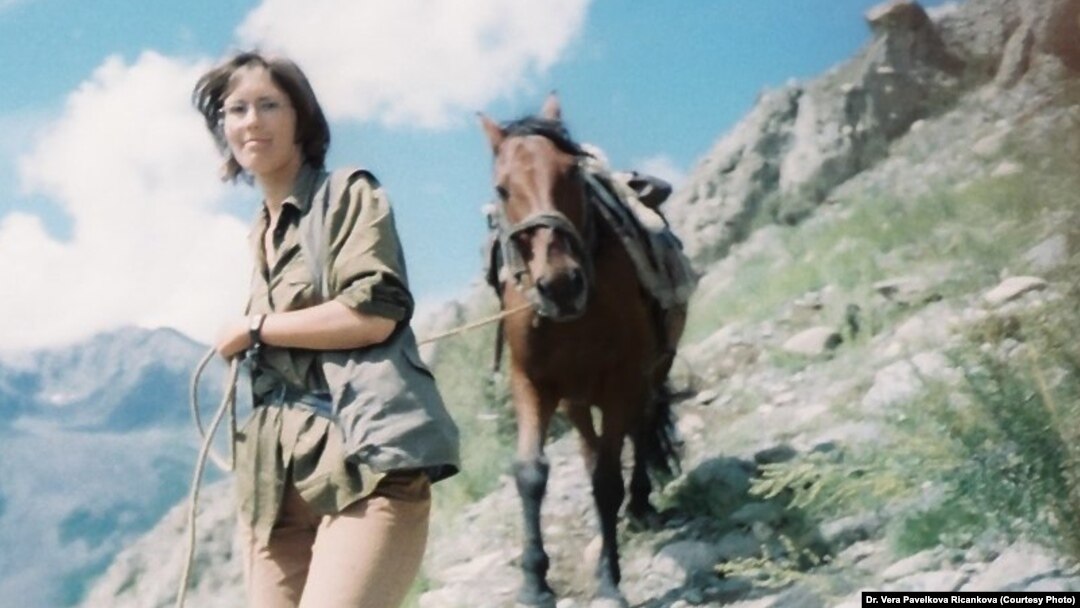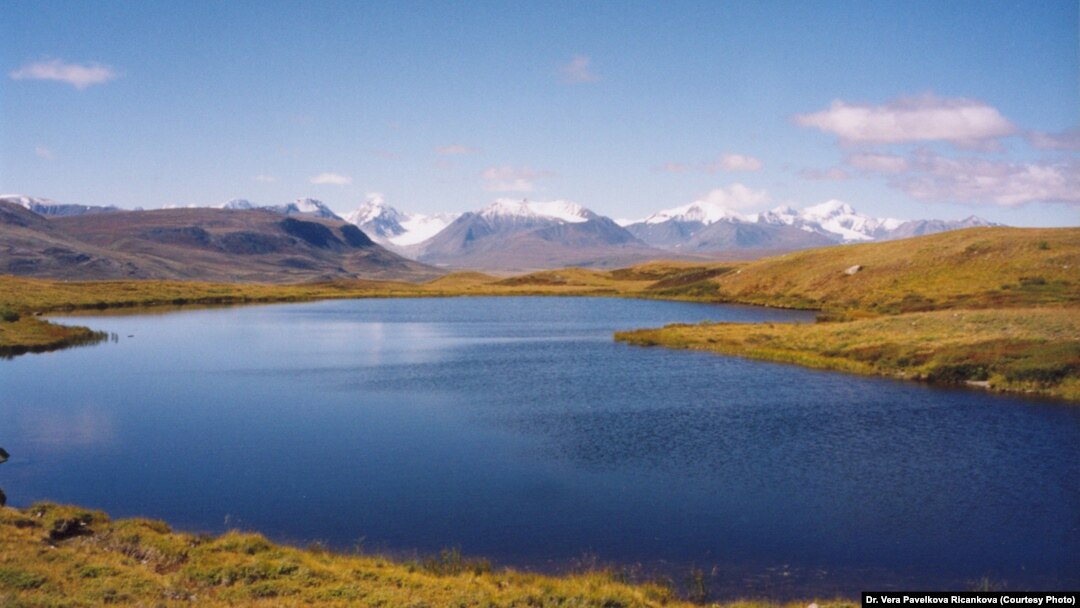If you ever wondered what the Ice Age looked like, then look no farther than Eurasia's Altai-Sayan mountains, where thriving mammalian communities are frozen in time.
Parts of the range along the Russia-Mongolian border have served as sanctuaries for Ice Age mammals since the last glacial period.
While the sizes and unique physical features of the mammals have evolved, the communities themselves are nearly identical to those that existed in the region during the Pleistocene era.
Czech scientists from the University of South Bohemia have compiled a list of mammals at seven Eurasian sites that lived between 35,000 and 12,000 years ago, and compared them with the mammals living today at 14 sites.
The leader of the team, Vera Pavelkova Ricankova, told RFE/RL that the results show that the closest modern equivalent to Ice Age ecosystems are found in the Altai and Sayan mountains.
"The steppe and tundra animals -- for example, horses and reindeer -- live here together in one national park," she said. "The Ice Age faunas are preserved in Ukok Plateau in [Russia's] Altai Republic, and in the Uvs Nuur and Khar Us Nuur in West Mongolia. The Ice Age mammals seem to persist up to the present in those areas where the forest belt doesn't separate alpine vegetation from steppes and deserts."
The mix of mammals found together in the region includes reindeer, saiga antelope, Przewalski's horse, and the steppe lemming. Apart from extinct species such as mammoths and woolly rhinos, there are few differences between these communities and their ancient counterparts.
Diverse Landscape
That's because conditions in the Altai-Sayan Mountains -- a combination of cold and dry climates – have barely changed since the last glacial period.
Another factor is the Altai-Sayan's varied topography. A mosaic of mountains, coniferous forests, steppe and wetlands, and alpine meadows supports a diverse community of plants and animals.
"We have what appears to be the closest thing to a modern analogue for the kinds of animals living in the end of the Ice Age," says John Stewart, associate professor in Palaeoecology at Bournemouth University in Britain. "[This] is tremendously useful because, if we want to try and understand other aspects of this Ice Age time, we can presumably learn quite a lot from studying the ecology of the Altai-Sayan area."

Stewart and Pavelkova Ricankova say evidence suggests that the Altai-Sayan Mountains may have been a refugium for mammals as well as other animals and plants that were abundant in full-glacial Eurasia, but went extinct in the regions that experienced climatic change. A few years ago in the Russian Altai, for example, Czech scientists found live relict terrestrial snail species that were characteristic of full-glacial Europe.
Stewart adds that the environment may have also preserved ancient humans through the ages.
"Certainly, this seems to be the general area where you get the greatest diversity of humans," he says. "It is in this general area that we have the only location of the three distinct populations found in Eurasia, [those] being ourselves -- the modern humans, the Neanderthals, and then the comparatively little-known population called the Denisovans. So, yes, it does seem that some of the very last individuals of this broader diversity of humans were found in this area."
In 2010, DNA analysis of remains excavated at the Denisova Cave in Russia's Altai Mountains revealed evidence of a human type, the Denisovans, who lived 40,000 years ago. The cave also contained a Neanderthal toe bone and modern human artifacts, meaning that at least three groups of people occupied the cave at different times. Further analysis has since revealed that the Denisovans interbred with a fourth group of early humans, possibly Homo erectus, which lived in Europe and Asia a million years ago.
According to Stewart, the Altai-Sayan region could contain many more surprises.
"This is the kind of area that has been studied relatively little," he says. "This is a frontier, if you like, for archeology and anthropology."
Parts of the range along the Russia-Mongolian border have served as sanctuaries for Ice Age mammals since the last glacial period.
While the sizes and unique physical features of the mammals have evolved, the communities themselves are nearly identical to those that existed in the region during the Pleistocene era.
Czech scientists from the University of South Bohemia have compiled a list of mammals at seven Eurasian sites that lived between 35,000 and 12,000 years ago, and compared them with the mammals living today at 14 sites.
The leader of the team, Vera Pavelkova Ricankova, told RFE/RL that the results show that the closest modern equivalent to Ice Age ecosystems are found in the Altai and Sayan mountains.
"The steppe and tundra animals -- for example, horses and reindeer -- live here together in one national park," she said. "The Ice Age faunas are preserved in Ukok Plateau in [Russia's] Altai Republic, and in the Uvs Nuur and Khar Us Nuur in West Mongolia. The Ice Age mammals seem to persist up to the present in those areas where the forest belt doesn't separate alpine vegetation from steppes and deserts."
The mix of mammals found together in the region includes reindeer, saiga antelope, Przewalski's horse, and the steppe lemming. Apart from extinct species such as mammoths and woolly rhinos, there are few differences between these communities and their ancient counterparts.
Diverse Landscape
That's because conditions in the Altai-Sayan Mountains -- a combination of cold and dry climates – have barely changed since the last glacial period.
Another factor is the Altai-Sayan's varied topography. A mosaic of mountains, coniferous forests, steppe and wetlands, and alpine meadows supports a diverse community of plants and animals.
"We have what appears to be the closest thing to a modern analogue for the kinds of animals living in the end of the Ice Age," says John Stewart, associate professor in Palaeoecology at Bournemouth University in Britain. "[This] is tremendously useful because, if we want to try and understand other aspects of this Ice Age time, we can presumably learn quite a lot from studying the ecology of the Altai-Sayan area."

Czech researcher Vera Pavelkova Ricankova
Stewart and Pavelkova Ricankova say evidence suggests that the Altai-Sayan Mountains may have been a refugium for mammals as well as other animals and plants that were abundant in full-glacial Eurasia, but went extinct in the regions that experienced climatic change. A few years ago in the Russian Altai, for example, Czech scientists found live relict terrestrial snail species that were characteristic of full-glacial Europe.
Stewart adds that the environment may have also preserved ancient humans through the ages.
"Certainly, this seems to be the general area where you get the greatest diversity of humans," he says. "It is in this general area that we have the only location of the three distinct populations found in Eurasia, [those] being ourselves -- the modern humans, the Neanderthals, and then the comparatively little-known population called the Denisovans. So, yes, it does seem that some of the very last individuals of this broader diversity of humans were found in this area."
In 2010, DNA analysis of remains excavated at the Denisova Cave in Russia's Altai Mountains revealed evidence of a human type, the Denisovans, who lived 40,000 years ago. The cave also contained a Neanderthal toe bone and modern human artifacts, meaning that at least three groups of people occupied the cave at different times. Further analysis has since revealed that the Denisovans interbred with a fourth group of early humans, possibly Homo erectus, which lived in Europe and Asia a million years ago.
According to Stewart, the Altai-Sayan region could contain many more surprises.
"This is the kind of area that has been studied relatively little," he says. "This is a frontier, if you like, for archeology and anthropology."


